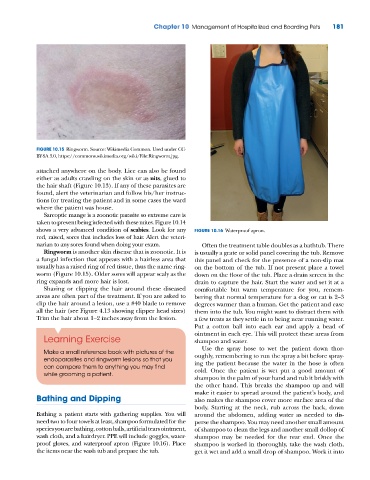Page 197 - Zoo Animal Learning and Training
P. 197
Chapter 10 Management of Hospitalized and Boarding Pets 181
FIGURE 10.15 Ringworm. Source: Wikimedia Common. Used under CC-
BY-SA 3.0, https://commons.wikimedia.org/wiki/File:Ringworm.jpg.
attached anywhere on the body. Lice can also be found
either as adults crawling on the skin or as nits, glued to
the hair shaft (Figure 10.13). If any of these parasites are
found, alert the veterinarian and follow his/her instruc-
tions for treating the patient and in some cases the ward
where the patient was house.
Sarcoptic mange is a zoonotic parasite so extreme care is
taken to prevent being infected with these mites. Figure 10.14
shows a very advanced condition of scabies. Look for any FIGURE 10.16 Waterproof apron.
red, raised, sores that includes loss of hair. Alert the veteri-
narian to any sores found when doing your exam. Often the treatment table doubles as a bathtub. There
Ringworm is another skin disease that is zoonotic. It is is usually a grate or solid panel covering the tub. Remove
a fungal infection that appears with a hairless area that this panel and check for the presence of a non‐slip mat
usually has a raised ring of red tissue, thus the name ring- on the bottom of the tub. If not present place a towel
worm (Figure 10.15). Older sores will appear scaly as the down on the floor of the tub. Place a drain screen in the
ring expands and more hair is lost. drain to capture the hair. Start the water and set it at a
Shaving or clipping the hair around these diseased comfortable but warm temperature for you, remem-
areas are often part of the treatment. If you are asked to bering that normal temperature for a dog or cat is 2–3
clip the hair around a lesion, use a #40 blade to remove degrees warmer than a human. Get the patient and ease
all the hair (see Figure 4.13 showing clipper head sizes) them into the tub. You might want to distract them with
Trim the hair about 1–2 inches away from the lesion. a few treats as they settle in to being near running water.
Put a cotton ball into each ear and apply a bead of
ointment in each eye. This will protect these areas from
Learning Exercise shampoo and water.
Use the spray hose to wet the patient down thor-
Make a small reference book with pictures of the oughly, remembering to run the spray a bit before spray-
endoparasites and ringworm lesions so that you ing the patient because the water in the hose is often
can compare them to anything you may find cold. Once the patient is wet put a good amount of
while grooming a patient.
shampoo in the palm of your hand and rub it briskly with
the other hand. This breaks the shampoo up and will
make it easier to spread around the patient’s body, and
Bathing and Dipping also makes the shampoo cover more surface area of the
body. Starting at the neck, rub across the back, down
Bathing a patient starts with gathering supplies. You will around the abdomen, adding water as needed to dis-
need two to four towels at least, shampoo formulated for the perse the shampoo. You may need another small amount
species you are bathing, cotton balls, artificial tears ointment, of shampoo to clean the legs and another small dollop of
wash cloth, and a hairdryer. PPE will include goggles, water- shampoo may be needed for the rear end. Once the
proof gloves, and waterproof apron (Figure 10.16). Place shampoo is worked in thoroughly, take the wash cloth,
the items near the wash tub and prepare the tub. get it wet and add a small drop of shampoo. Work it into

